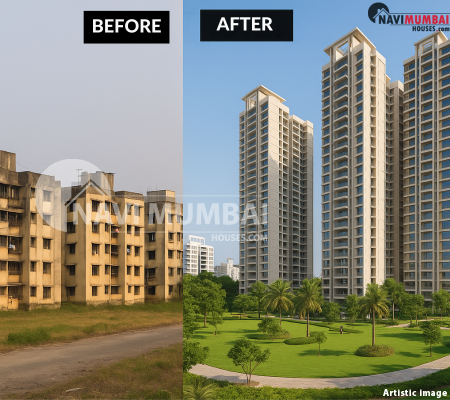
Before: The Problem in Conventional Redevelopment
Mumbai and its suburbs (including Navi Mumbai’s nodes like Vashi) have many old buildings/housing societies built decades ago. Some of the issues:
-
Aging structures: weak foundations, plumbing, wiring, and no earthquake resistance.
-
Inadequate amenities: lack of open spaces, parking, and modern infrastructure.
-
Multiple ownership structures, small plots, and legacy rights make redevelopment complex.
-
High cost & risk for single buildings to redevelop alone: legal, financial, coordination hurdles.
Traditional single-building redevelopment often struggles to deliver scale, modern design, or communal benefits
After: What Cluster Redevelopment Can Achieve
In cluster redevelopment, multiple neighboring buildings (clusters) are redeveloped together under a unified plan. The benefits can include:
-
Better utilization of land — shared podiums, green areas, and central amenities.
-
Economies of scale — shared costs for infrastructure, roads, utilities.
-
Improved infrastructure & roads across the cluster, not just individual plots.
-
Design coherence — uniform layout, better urban streetscape, improved ventilation, and open space.
-
Fair exchange between old and new units — original residents get modern flats, sometimes larger, with better amenities.
-
Shared community resources — clubhouses, parking, landscaping, security become viable when spread over a cluster scale.
In Vashi, cluster redevelopment can breathe new life into older society blocks, improve property values for all, and attract better infrastructure investment. If done well, Vashi could become a showcase for Navi Mumbai’s urban renewal.
Key Steps & Stakeholders
-
Formation of Cluster Body / Consortium
Societies or residents of multiple adjacent blocks form a cluster redevelopment consortium or trust. -
Land pooling & formation of a master plan
The land parcels of these buildings are pooled. A modern master layout plan is created, involving roads, services, utilities, and aesthetics. -
Agreement with Developer / Special Purpose Vehicle (SPV)
The cluster consortium signs a development agreement with a developer or SPV that does the construction, infrastructure, and delivery. -
Swap / Allotment of flats
Existing residents are allotted new flats in the new towers based on contribution (area, rights). Often, there is a premium portion reserved for the developer to monetize. -
Implementation, approvals & construction
Because it’s a cluster, authorities may grant streamlined approvals. Infrastructure like sewer, roads, water, and power are upgraded. -
Possession & handover/maintenance
Residents move into new units. Common infrastructure is handed over to society. The developer may assist with maintenance.
Why Vashi is a Good Candidate
-
Vashi has many older societies from the 1980s–1990s, ripe for modernization.
-
Good connectivity (rail, road, metro potential) increases the future value of modernized housing.
-
Land rates in Vashi are already high; modernization adds a premium.
-
The municipal / CIDCO willingness to support redevelopment in nodes like Vashi is relatively stronger (compared to fringe nodes).
-
Residents may favor staying in the same locality rather than relocating far away.
Example / Hypothetical Scenario
Suppose three adjacent societies in Vashi (each ~0.5 acre) agree to cluster redevelopment:
-
Total land ~1.5 acres → new towers of 8–12 floors.
-
Original 150 flats will get new 200 flats (due to FSI upgradation, open area, cluster efficiency).
-
50 flats (developer share) will be sold to subsidize infrastructure costs.
-
Shared benefits: parks, wider internal roads, green spaces, dedicated parking, and better amenities.
Challenges & What To Watch Out For
-
Consensus & coordination: Getting multiple societies to agree can be difficult — differing valuations, expectations.
-
Legal / title complexity: Differing ownership documents, pending litigation, and unclear titles among multiple properties.
-
Developer trust & selection: The SPV must be credible, with a strong delivery track record.
-
Regulatory / approval delays: Even for clusters, approvals (from municipality, infrastructure agencies) may be slow.
-
Cost distribution & fairness: Ensuring original residents don’t bear undue burden or loss.
Tips / Best Practices for a Successful Cluster Redevelopment (Vashi & Beyond)
-
Strong governance mechanism
Use neutral experts, Chartered engineers, and clear protocols on decision-making. -
Transparent valuation model
Use independent valuers to determine share allocation for the existing vs developer portion. -
Phased implementation with buffer timelines
Build in realistic buffers for delays, approvals, and delivery. -
Engage with authorities early
Seek support or special incentives from CIDCO / municipal bodies to ease approval, give concessions. -
Ensure continuity for residents
Temporary housing, compensation, or ready flats for residents should be part of planning. -
Sustainability & design
Green design, efficient water, waste management, and open spaces should be integrated, not afterthoughts. -
Financial modeling with margin for contingencies
Project cost overruns, interest, inflation, and keep margins safe. Conclusion
ConclusionCluster redevelopment offers a smarter, more holistic path to urban renewal than piecemeal redevelopment of single blocks. In Navi Mumbai, Vashi stands out as a strong candidate for this model, with existing infrastructure, connectivity, and resident willingness. If society consortia, capable developers, and supportive authorities align, Vashi’s cluster redevelopment could become a template for modernizing other nodes across Navi Mumbai.
For buyers, residents, and civic planners, cluster redevelopment in Vashi is a chance to transform aging housing stock into reliable, modern, high-value communities — while retaining locality, heritage, and continuity.
Visit us: @ 8433959100 or www.navimumbaihouses.com
The post Cluster Redevelopment in Navi Mumbai: How Vashi Is Leading the Way appeared first on .

